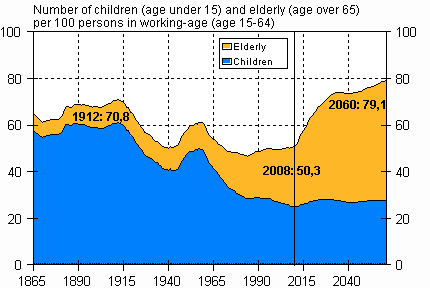Published: 30 September 2009
Population projection 2009–2060
Population growth is set to continue in Finland even in future. According to a fresh population projection of Statistics Finland, on the assumption that the present development continues, the population of Finland will exceed 6 million in 2042. The projection is based on observations on past development in fertility, mortality and migration.
The projection has been made for the whole country up to 2060 and by region up to 2040. The projection is based on the assumption that the birth rate and migration gain from abroad remain at their observed levels and the observed decline in mortality will continue. According to the projection, the annual number of deaths will exceed births in 2034, but net immigration is forecast to sustain population growth even after this. The volume of net immigration is assumed to be 15,000 persons.
The proportion of persons aged over 65 in the population is estimated to rise from the present 17 per cent to 27 per cent by 2040 and to 29 per cent by 2060. The proportion of people of working age in the population will diminish from the present 66 per cent to 58 per cent by 2040 and to 56 per cent by 2060. The number of persons of working age will start to fall in 2010 when the large, post-war baby boom generations reach retirement age.
The demographic dependency ratio, that is, number of children and pensioners per one hundred persons of working age will go up quickly in the near future. At the end of 2008, the demographic dependency ratio was 50.3. According to the projection, the dependency ratio would be 60.4 in 2016 and would rise to 70.5 by 2026. In 2060, the demographic dependency ratio would be 79.1.
Demographic depedency ratio 1865–2060

The number of pensioners, i.e. persons aged 65 and over, will almost double from the present 905,000 to 1.79 million by 2060. The proportion of persons aged over 85 in the population is forecast to rise from the two per cent where is stood at the last turn of the year to seven per cent, and their number from the present 108,000 to 463,000.
Assuming that the trend of the past five years continues in internal migration, the population of the Region of Etelä-Savo will decrease by eight per cent from its present size by 2030. The projection foresees the next largest population decrease of six per cent in the Region of Kainuu. The largest relative increases in population are forecast to take place in the Regions of Åland, Itä-Uusimaa and Uusimaa. The sizes of their populations are estimated to grow by approximately 20 per cent from the present by 2030.
Statistics Finland’s population projections are demographic trend calculations based on past development in fertility, mortality and migration. The projections do not seek to estimate the effect of economic, socio-political regional policy and other such factors on population development. The calculations mainly indicate the outcome from the present development under the assumption that it continues unchanged. Thus, they should not be interpreted as descriptions of the inevitable. The task of a population projection is to provide tools with which decision-makers can assess whether measures need to be taken to influence the development.
Source: Population Statistics 2009. Statistics Finland
Inquiries: Markus Rapo (09) 1734 3238, vaesto.tilasto@stat.fi
Director in charge: Jari Tarkoma
Publication in pdf-format (286.8 kB)
- Tables
-
Tables in databases
Pick the data you need into tables, view the data as graphs, or download the data for your use.
Appendix tables
- Figures
-
- Population by age and gender 2010, projection 2009 (30.9.2009)
- Population by age and gender 2030, projection 2009 (30.9.2009)
- Population by age and gender 2050, projection 2009 (30.9.2009)
- Quality descriptions
Updated 30.9.2009
Official Statistics of Finland (OSF):
Population projection [e-publication].
ISSN=1798-5153. 2009. Helsinki: Statistics Finland [referred: 25.4.2024].
Access method: http://www.stat.fi/til/vaenn/2009/vaenn_2009_2009-09-30_tie_001_en.html

